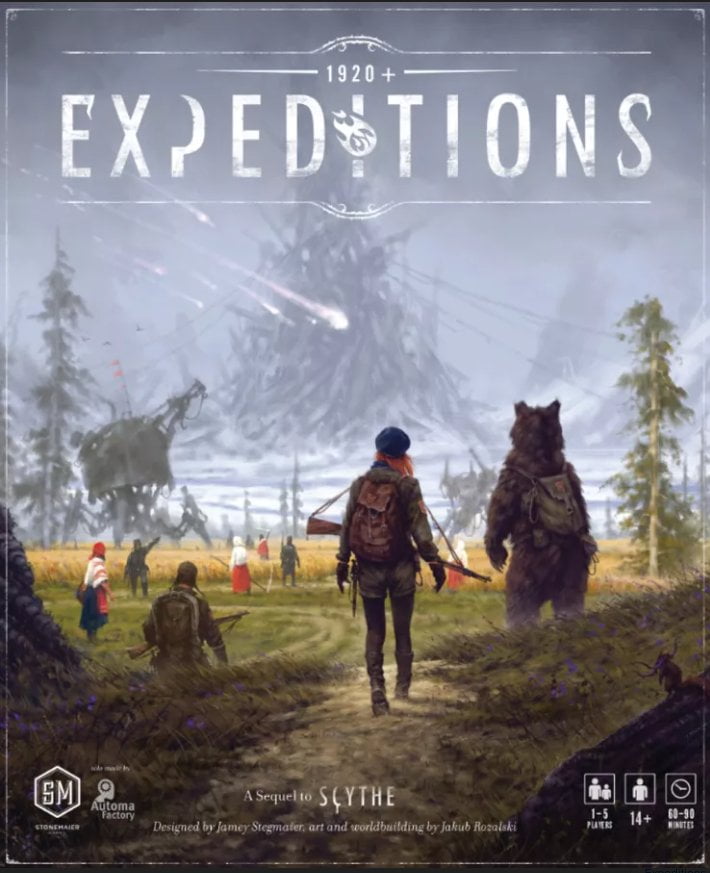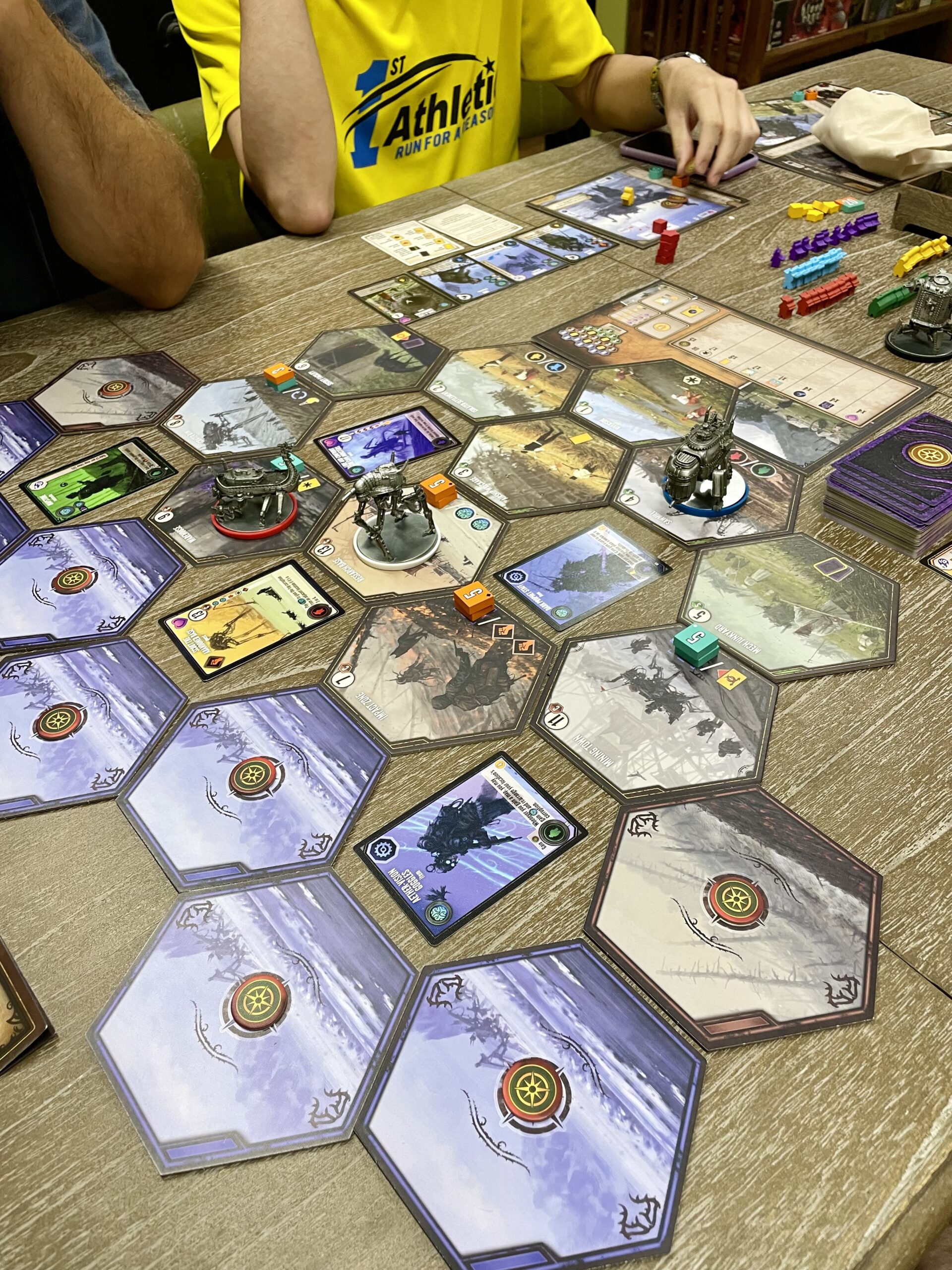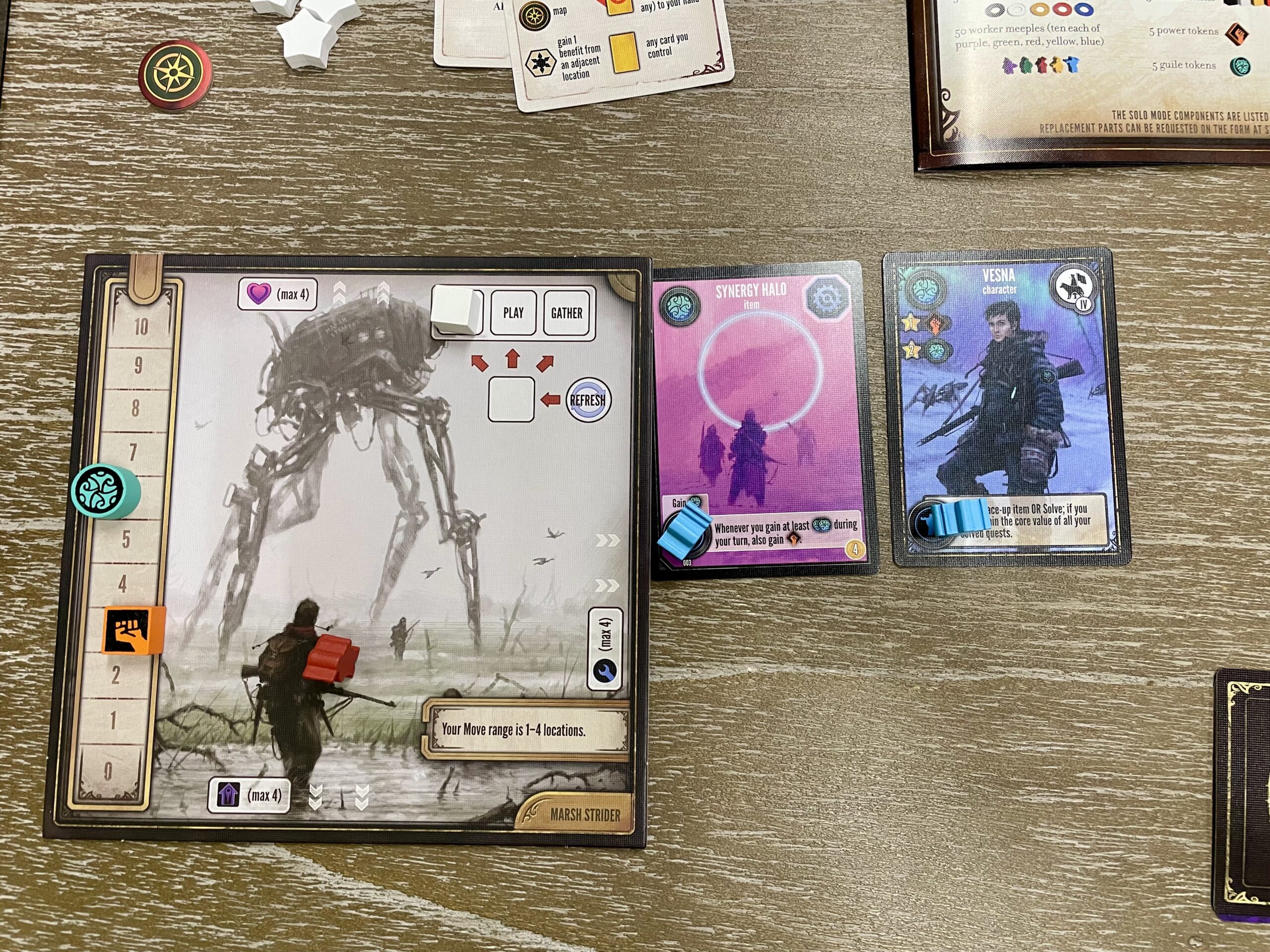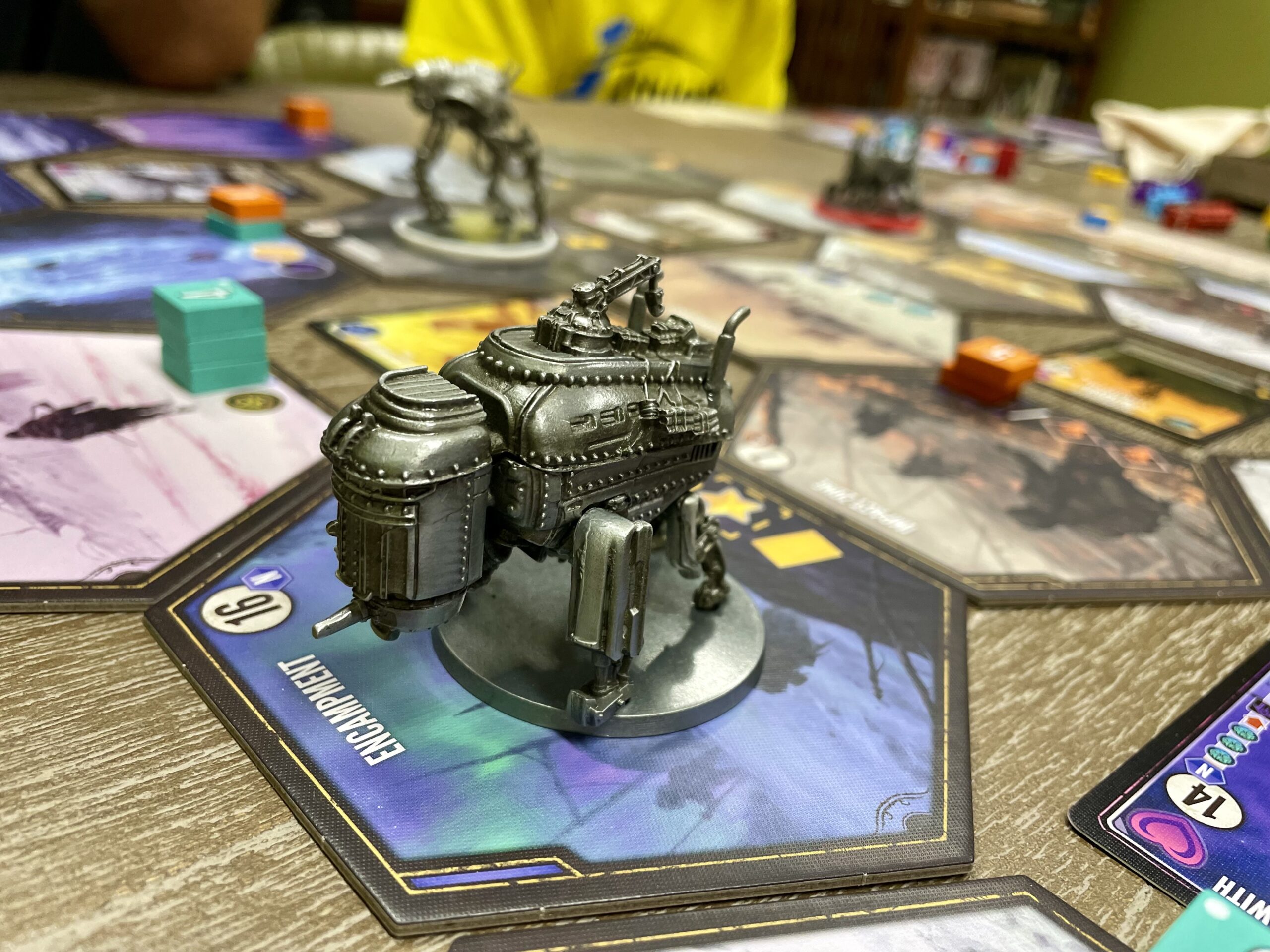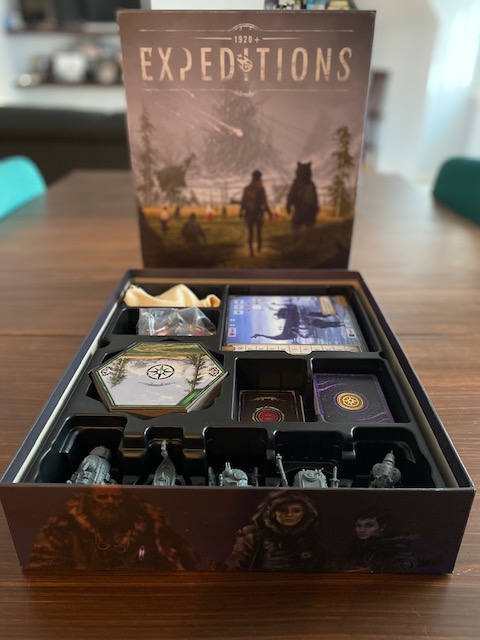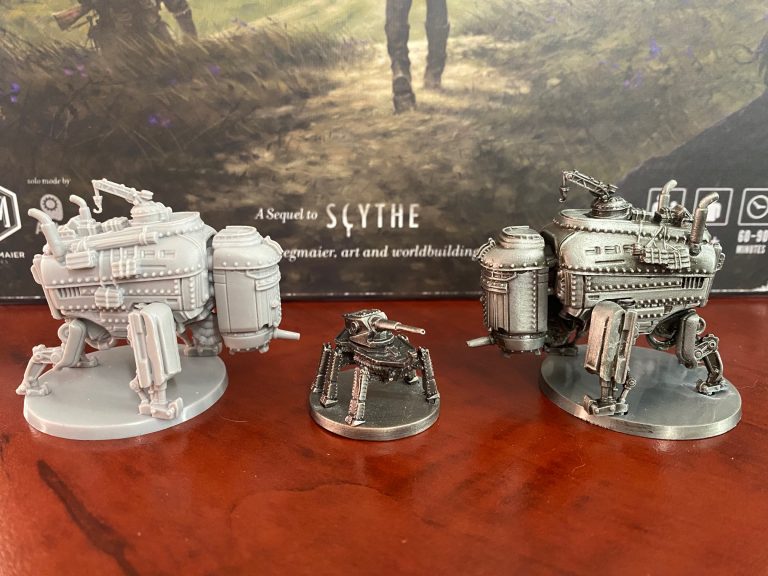The standalone sequel to Scythe, Expeditions a card-driven, engine building game that puts players in Siberia exploring a metoer crash site. This game isn't Scythe but brings over a lot of similar mechanical ideas.
I attended my weekly board game meetup, and to my surprise, Expeditions was on the table. Arriving late, I used the time as others finished a game of Raiders of the North Sea to punch out pieces and read through the rules.
Given my playgroup’s fondness for Scythe, there was excitement about exploring this new game. It’s essential to note that Expeditions is not a Scythe expansion; rather, it’s a sequel or a game set in the same universe, drawing some inspiration from Scythe’s gameplay and rules but introducing unique elements. In the upcoming sections.
I’ll share into my initial impressions of Expeditions, I experienced the game at both 3 and 4 player counts, I have yet to play at 1,2, and 5 players. I specifically, played a friends copy of the Ironclad Edition. While my feelings about the game are mixed, it’s crucial to emphasize that, despite any criticisms in this review, Expeditions is well-designed—it might just not align with everyone’s expectations or preferences.

Disclaimer: This post contains affiliate links. This means I may earn a commission should you chose make a purchase or sign up for a program using my link. Thank you for supporting the website!
Table of Contents
How to Play
Expeditions took Scythes limited action selection and turned it into a limited action “slider”. Players get to choose between Play, Gather, and/or Move. However on each turn your action token will cover up one of the actions, only keeping two other actions visible. Each turn you must select a new action to cover up. For example if a player used Play and Gather on one turn, they would have to move the action token from covering the move action and place it onto either play or gather, thus blocking that action. If the player moved it to play, only the gather and move action would be visible for their turn.
The Play action allows players to play cards
The Gather action allows players to take the benefit of their location
The Move action allows players to move 1-3 spaces to an unoccupied location.
Players can tuck cards under their mech mats through three different actions usually activated through playing cards “Solve” quests cards, “Meld” meteroite cards, and “Upgrade”
Some actions are only available through playing cards like “Solve“and “Vanquish” (to clear out corruption on a location) while others are only available through gathering like claiming “Glory“.
This is just a brief overview if you want to learn more in depth you can read the full rulebook provided by Stonemaier Games.
Rule Confusion
The game’s overall rules aren’t overly complex and, in my experience, are more straightforward than those of Scythe. However, the rulebook proved to be less than helpful in the learning process. The organization of the rulebook is confusing, with some concepts lacking clear explanations. Additionally, the use of unnecessarily convoluted terminology added an extra layer of difficulty to understanding the game. Turning to instructional videos, such as those from “Watch it Played,” proved to be a more effective way to grasp the mechanics and nuances of the game.
Confusing Terminology
There are some major oversights with some terminology in the game making the rules read extra hard and confusing forcing players to second guess almost every rule they have read. The mains issues are the use of the phrases: Your Hand, Cards in Your Control, and Face-up Cards.
“Your Hand”
Players never hold cards in their hand. ” Your Hand” is face-up cards to the left of the Mech mat.
“Cards in Your Control”
Cards in your control only include active and inactive cards, not cards from solving quests, melding, or upgrading.

“Face-up Cards”
All cards in this game are face-up, except for one deck of cards. “Your hand” is a pile of inactive face-up cards to the left of the Mech mat and players active cards are face-up to the right of the Mech mat. Any solved quests, upgrades, or melded cards that are tucked face-up under your Mech mat also do not count. So what are “Face-up” cards. They are the cards located amongst the game’s location tiles. Why are these cards not referred to as “Expedition” cards or “Explore” cards, or maybe even “Encounter” cards. Anything would have been less confusing than “face-up” cards. (see section on iconography for more confusion)

No Rule Clarifications
The rule book lacks a section for any clarifications. For example no Mech ability overviews and explaining how they work in more detail outside of the one line of text on the mech mats. Can Odin’s Wrath spend mat tokens multiple times in one turn? Well…the answer is yes! But the rule book doesn’t help us to come to that conclusion confidently.
There are some major oversights with some terminology in the game.
Gameplay
The game-play feels very different from Scythe but has a lot of similarities also. There’s a restricted action selection, first to 4 stars (glory tokens) ends the game, and end game scoring with popularity (quests) affecting score values. Like Scythe the pace starts out kind of slow, then everyone begins to figure out how to get their last few stars, then it’s over before plans are fully achieved.
Expeditions is the perfect example on how a sequel should be done. It took everything about Scythe’s core and made it a completely different game with a viable space on my shelf. It’s not without its issues though. Not everyone who loves Scythe will love Expeditions too.
Expeditions is the perfect example on how a sequel should be done.
Efficiency
Similar to many games, efficiency plays a crucial role in achieving victory, and in Expeditions, the pursuit of Glory (stars) accentuates this aspect even more. During gameplay, there’s a continuous need for strategic planning, typically looking ahead to the next 2-3 turns. Success hinges on a well-thought-out sequence of decisions. The interplay of actions, movements, and card plays creates a dynamic and engaging experience that keeps players engaged. I find great satisfaction in games that demand this level of foresight, and Expeditions executes this requirement admirably.
No Player Interaction
Jamey Stegmaier has notably prioritized steering clear of negative “take-that” actions in Stonemaier’s core game design philosophy. This approach is evident in many of Stonemaier’s games. For me, the ideal board games for gaming with my wife are those with minimal negative interaction. However, this faced criticism in the case of Scythe, as some expected a more pronounced 4x game with intense mech battles. Personally, I appreciated the subtlety, where the focus wasn’t solely on battles but on the strategic tension of avoiding them.
Expeditions, on the other hand, seemed to swing the pendulum too far in avoiding negative player interactions. The only form of interaction present is the potential for unintentional “blocking” of another player from a desired space. This occurrence is infrequent and typically happens accidentally or toward the game’s conclusion. Throughout most of the game, players can easily navigate around others, essentially ignoring their moves. While this design choice aims to eliminate bad experiences from player interactions, it, unfortunately, results in a somewhat lackluster experience.
Results in a somewhat lackluster experience.
Exploration
Exploration in the game lacks the tension needed to make it truly engaging. The process is rather straightforward: players move to an unrevealed tile, unveil it, and then place corruption tokens until they match or exceed the specified number on the tile. While these corruption tokens do obstruct one of the actions on the tile, there’s usually an alternative action available, rendering the decision relatively tension-free. The absence of risk diminishes the overall excitement in decision-making during exploration.
Theme
Being a devoted fan of Scythe and its intricate world, the news of another game set in this immersive universe left me eagerly anticipating what was to come. My initial introduction to Scythe led me to explore Jakub Rozalski‘s captivating artwork on his website, deepening my connection to this fictional realm. Despite this, a thirst for more lore persisted, a craving for additional narratives, whether in the form of a book or a comic.
With the arrival of Expeditions, my desire for more content set in the Scythe universe has finally been fulfilled. In this latest installment, players embark on an “Expedition,” venturing into a region affected by a meteor strike and corrupted by radiation. The overarching goal is to combat and eliminate the pervasive corruption from the land while concurrently undertaking quests and various other challenges. The thematic depth and the carefully crafted world surrounding this premise align seamlessly with my appreciation for the Scythe universe.
Why “Expeditions”
This isn’t a complaint that should affect whether you buy the game or not, but why is the game called “Expeditions”? The board gaming world already houses several titles with similar names, including one released in 2023, Expeditions: Around the World (just take a look at my BGG search in the images below). The decision to go with a generic title seems to miss an opportunity for something more distinctive. Why wasn’t it named after its specific setting, perhaps something like “The Tunguska Expedition” or even just “Tunguska,” directly referencing the location of the expedition. In contrast Scythe cleverly and thematically, encapsulates both the idea of harvest and war. I’d hoped for a title that would similarly capture the unique essence of this game but it fails to do so.
Theme and Mechanics
The game’s mechanics are solid, offering a well-constructed system. However, where it falls short is in the integration of these mechanics with the thematic elements.
Power and Guile, functioning as resources on the mech mat, which serve as a somewhat abstract representations of “will” and “strength” to overcome obstacles. When the Power and Guile tiles are applied to newly revealed locations to represent various challenges like mutated monsters or challenging terrain, the thematic connection feels lacking. A numerical tile doesn’t quite capture the physical presence or threat one might expect. A more immersive experience could benefit from additional thematic elements or lore to enhance the representation of these challenges.
Quests, another game mechanic that suffers from a similar abstraction. Players are required to reach a specific location and play a card to complete a quest. Despite having card titles that offer a glimpse into the task at hand, often these titles are overlooked since they don’t impact gameplay. Moreover, the absence of flavor text or decision-making options akin to Scythe‘s Encounter cards further diminishes the thematic depth of the quests. Thematic storytelling and immersion seem to take a back seat to the mechanics in this aspect of the game.

Lovecraftian like Monsters
The game exhibits some Lovecraftian influences, which is evident in Jakub Rozalski‘s art. While these concepts were present in his artwork on his personal website, their integration into the Scythe world might feel confusing or unusual for some players. Personally, I don’t mind this creative direction; however, I wish they had visually emphasized it more through game pieces or miniatures rather than maintaining a more abstract approach.
Where it falls short is in the integration of these mechanics with the thematic elements.
Strategic Depth
The game offers a variety of viable strategies, ensuring that there are numerous ways to achieve victory. Whether you focus on scoring significant points or aim to conclude the game swiftly, the availability of seven distinct options to achieve the four Glory (stars) required to end the game provides ample strategic depth. Additionally, players can earn extra points beyond stars through various means, such as Melding cards or gaining one coin per Guile and Power token.
Balance
The game exhibits a more balanced feel compared to Scythe, avoiding the presence of overpowered factions dominating the gameplay. While the asymmetrical powers are not entirely equal, their impact on balance can shift by factors such as player count, individual strategies, and card draws. Opinions on the best factions may vary widely, influenced by the play style of a specific group and the average player count.
The game exhibits a more balanced feel compared to Scythe
Tiers
Note: The following sections will delve into different tiers and strategies for mechs and cards. If you prefer to explore this information during gameplay, please skip to the next section. It’s crucial to maintain fairness within the playgroup, as sharing any insights gained enhances the overall gaming experience. It’s not enjoyable to engage in a board game where one player has prepared strategies unknown to the rest of the group. Proceed with caution or click here to skip to next section.
Mech Teir
- Tatanka allows players to tuck 5 cards instead of 4 for Quests, Melds, and Upgrades. This can be really powerful if players are able to tuck 5 Quests and Melds. Players can easily score 30+ points just by the melds alone. Since every time a player Melds they also score all previous Melds (usually maxed at $3), the Tatanka player could optimize their Melds to score like this, $3 + $6 + $9 + $12 + $15 = $45 from Melding Meteorites. Potentially $15 more then what other players can get from Melding. However it can be very situational. Not getting the right meteors or not getting a 5th meteor at all can be a problem. The issue with Tatanka is that Quests are the majority of cards in the deck. Coming by 5 meteors could be a little harder to accomplish but very doable.
- Highlander let’s players draw a card straight to their hand instead of having to place it in the active pool (without activating it). This means players will save having to do cleanup turns allowing them to get more full turns out of the game and the bonus of being able to use the card right away or on the following turn.
- Odin’s Wrath allows players to collect map tokens which are otherwise mostly useless to players and turns it into a resource. Odin Wrath is able to convert map tokens into power or guile on the fly or exchange them for money which is straight up points in this game. The nice thing about this mech is players can exchange as many tokens as they want in a single turn. This allows players to save up map tokens only to use them when needed most. However with larger player counts or playing with players who are more aggressively exploring new tiles this mech all of a sudden becomes less useful.
- Lumberjack allows players to spend 1 less to Vanquish. This can be nice but is limited to its usefulness for achieving other stars.
- Marsh Strider allows the player to move 4 spaces instead of 3. This gives the player more flexibility and capability to reach needed tiles especially when others are blocked by other players. This mech is even more powerful when playing with 4-5 players. But overall isn’t a huge advantage as players are rarely trying to block other players.
Card Tier
- Repair Damaged Mech (Quest) “Rescue all other cards. If you rescue at least 3 cards this way, gain $3” This means that every 4 turns a player can gain $3. Which is pretty good. Cards that are rescued can be cards you played or cards you gained during your turn. The main goal with this card is to play cards and gain face-up cards as much as possible. Players will want to have a card paired with another card that allows them to rescue Repair Damaged Mech to keep the engine going.
- Leechstone (Meteorite) allows players to refresh all their played cards including Leechstone itself. This would save players from ever having to do a Refresh turn. Plus as a bonus when it’s Melded the card will give players $1 per player. While most other Meteorite cards are capped at Max $3 and will require some effort to get full points. For example, Questone says “Gain $1 per quest you control.” with a max of $3. In a 5-player game, with the Tatanka Mech ability, the Leechstone card could score up to $25!

Game Visuals
Game Art
The artwork in this game is truly stunning, a testament to the talent of Jakub Rozalski, the same artist who envisioned the universe of Scythe and Expeditions. In Expeditions, the art takes center stage, elevating the visual experience to new heights. The box itself showcases beautiful artwork, and what’s even more impressive is that every single card in the game boasts a unique piece of art. With a total of 102 cards, each featuring its own illustration, the attention to detail is commendable. An interesting thematic touch we noticed was that some of the Mechs in the game are depicted in the locations, adding an extra layer of cohesion and immersion to the overall aesthetic.
Bad Iconography
The iconography in this game is a mixed bag, excelling in some areas while falling short in others. Overall, Stonemaier Games does an excellent job of incorporating intuitive icons to replace text wherever possible. Most of the icons on cards become clear and easy to understand after a play or two, contributing to a smooth gaming experience.
However, there are certain out-of-place icons, particularly in relation to the Yellow Card icons, that introduce unnecessary confusion. Simple tilts or alterations to these icons can significantly change the meaning of the card, creating an additional layer of complexity that could be streamlined for a more user-friendly experience.
The two worst offenders are “Cards You Control” and “Face-up Cards“. Both icons feature a yellow card (see images below). However, one is slightly tilted. There is no reason for players to associate a tilted card with “Face-up Cards” And again “Cards You Control” are also face-up on the table adding to the confusion.
Components
Mechs
The game comes with mechs that are beautifully designed. The mechs are generously sized, enhancing the overall aesthetic and contributing to an impressive table presence. Depending on the edition of the game, players can expect either plastic mechs featuring a plastic base ring or, in the “Ironclad Edition,” metal mechs paired with a rubber base ring, providing a premium and tactile component quality.
Plastic
Unfortunately, I’m unable to provide insights into the experience with the plastic mechs, as I haven’t had the opportunity to play that version.
Metal
The metal mechs are gorgeous and have a really nice weight to them when playing. It definitely gives it more of a heavy machinery mech-like feel. The copy my friend received did have a broken mech that came in the box. Stonemaier games provided great customer service by promptly replacing the broken mech for them. We found that the rubber rings didn’t fit very well to the metal mechs; they seemed to be too small. Overtime as the rings get used maybe they will stretch out a bit and fit better, but as of now I don’t really know.

Coins
In Expeditions the same coins are used as in Scythe. But for some reason in Expeditions they slightly changed the colors of some of the coins and also the 1 coin no longer has a hole punched out in the middle. I’m not sure if there is “lore” behind this change, I’m assuming not. I’m saddened to not have the finer detial of the hole punch. It feels like a downgrade from Scythe. This is a very nit picky complaint though nothing that should affect the overall enjoyment of the game or purchasing decisions.
Table Presence
The game has a very large table presence. The mechs on the table look awesome with their large size. Yet, the need for substantial table space is not solely dictated by the mechs; the size of the location tiles also contributes to this spatial demand. It seems the decision to enlarge these tiles was driven by the desire to provide enough room for both placing mechs and ensuring players can readily read the information displayed on a location.
However, a more significant spatial concern arises from the unique approach to card play in the game. Rather than holding cards in hand, players lay them out to the left of their Mech mat. The challenge here is that these inactive cards take up valuable table space, contributing to potential clutter. Meanwhile, active cards are positioned to the right of the Mech mat. This setup, while offering visibility, prompts the question of its practicality, as opponents are not actively engaging with the information on the inactive cards.
This choice in card presentation brings an interesting dynamic to the gameplay but introduces a trade-off in terms of table real estate. Players may find themselves grappling with the challenge of maximizing the available play area, especially on tables of more smaller proportions.

The Box
The box itself is visually stunning, eagerly awaiting its turn to be played. Its aesthetic appeal is not only a testament to the game inside but also positions it as the kind of box one proudly displays atop the shelf. The cover has vibrant colors that strike a balance with its more serious tones. The overall color scheme of the game contributes to a visually pleasing and well-contrasted presentation.
The kind of box one proudly displays atop the shelf.
Can Expeditions Fit on a Kallax? Almost.
The size of the box could be an annoyance for some depending on the shelf. The box is clocked in at 15.35 x 12.6 x 3.15 inches. To compare, Scythe is 14.57 x 11.81 x 3.94 inches and Wingspan (my favorite box size) is 11.5 x 11.5 x 3 inches. The Ikea Kallax shelf is 13.25 high x 15.375 deep. It fit on a Kallax but with a little overhang. I played a friend’s copy so can’t place it on my own Kallax to show you.
Box Insert
Expeditions boasts an outstanding plastic insert that exemplifies thoughtful design—an approach that I wish every board game company would adopt when crafting their inserts. Everything finds its designated place seamlessly. The inclusion of removable component trays facilitates swift and efficient setup, adding a layer of convenience to the gaming experience. One particularly commendable feature is the foresight to intentionally incorporated extra space in the insert to accommodate future expansions. Additionally, the insert is made for sleeved cards. Eliminating the frustration often associated with inserts that don’t accommodate sleeved cards. This insert encompasses all the essential elements I desire in a well-designed, user-friendly insert.

Expeditions Version Comparison
| Expeditions | Expeditions: Ironclad Edition | |
|---|---|---|
| Mechs | Plastic | Metal |
| Base Snaps | Plastic | Silicone |
| Box | Regular | Individually numbered box with foil lettering |
| MSRP | $85 | $115 |
Expansions
No expansions have been officially announced yet, though Jamey Stagmaier has been very active in talking about future plans. The insert included in the game does have a spot reserved for two new mechs and mech mats. We can definitely count on new factions coming in the future!
Final Verdict
Upon my initial encounter with Expeditions, I was brimming with excitement, captivated by the stunning art and visual aesthetics of the game. However, the overall experience left me somewhat disappointed initially. It’s challenging to discern whether this stems from elevated expectations or a genuinely lackluster gameplay experience. Reflecting on this, I find myself contemplating how my perception might differ if Expeditions were not a Stonemaier game or a Scythe sequel. The subsequent plays of the game have certainly deepened my appreciation, and I hold optimism that potential expansions might elevate the game into something more. It even made it into my Top 10 Board Games from 2023. Yet, as it stands, my feelings toward the game remain somewhat ambivalent.







